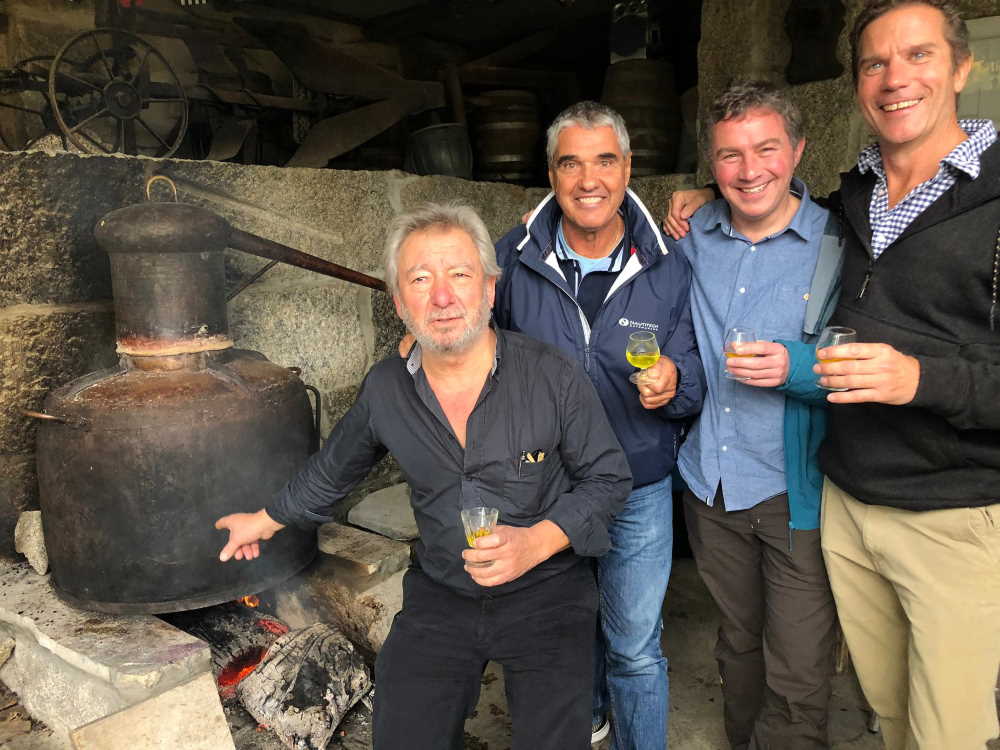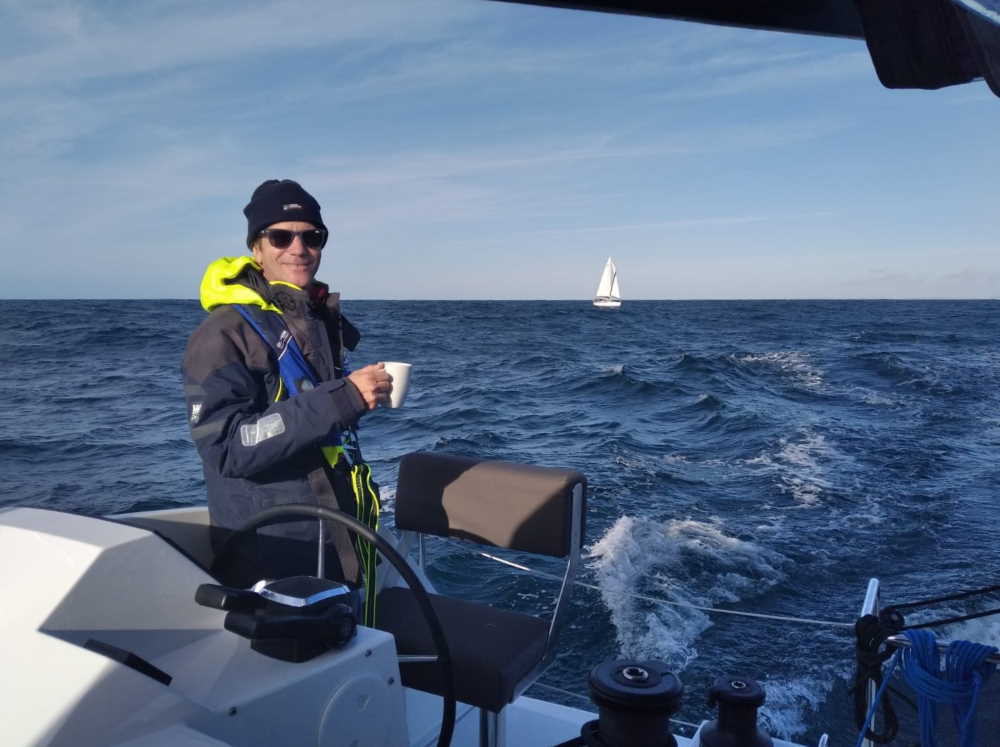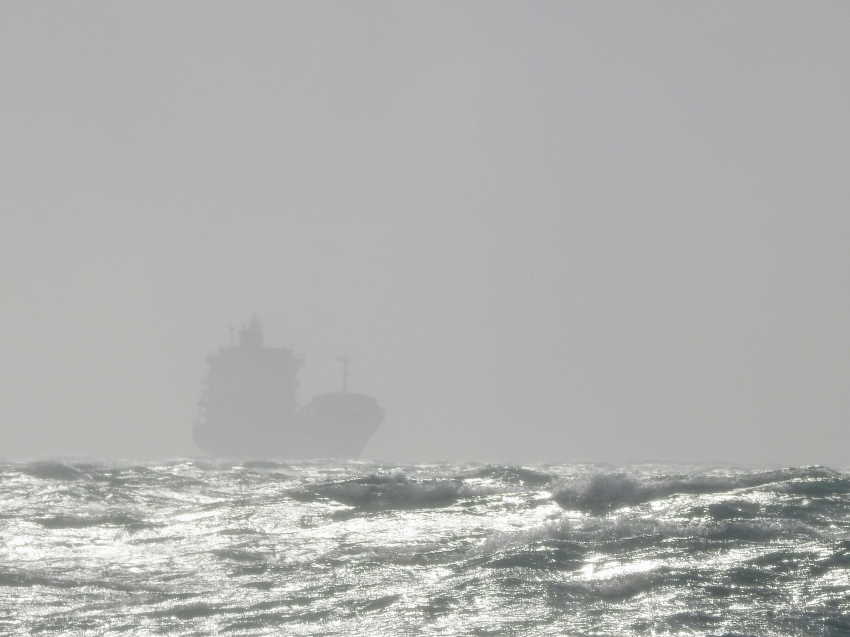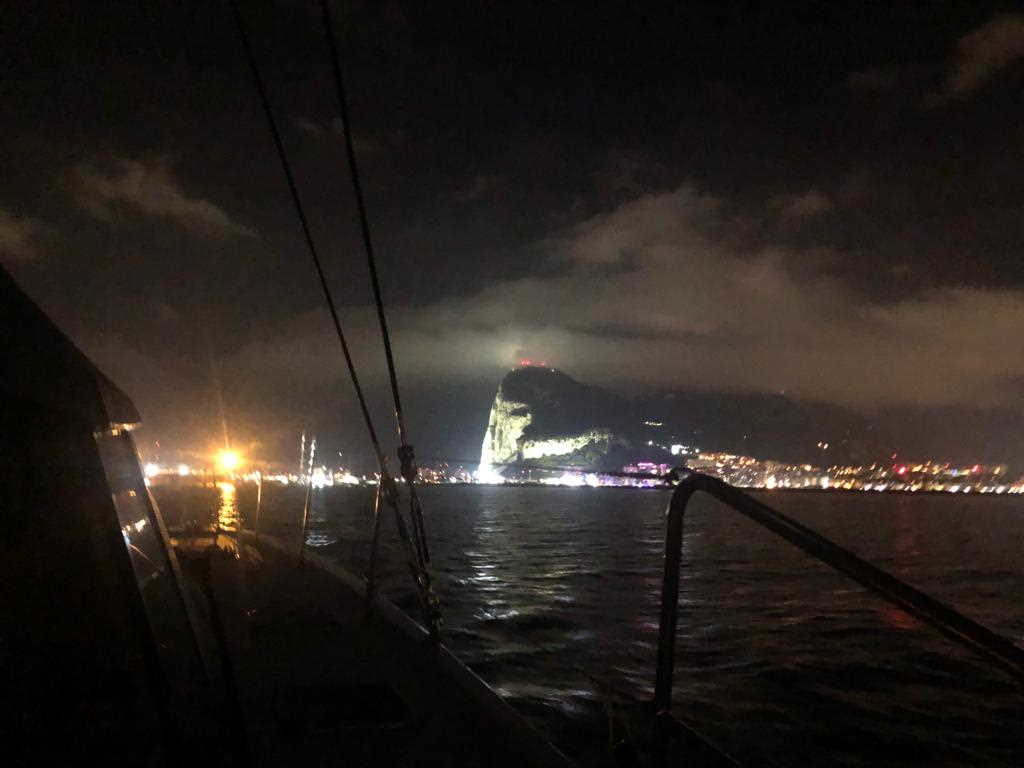Gecko Shake Down Cruise Leg 4
Vigo 16 November 2019, then South to Gibraltar
Delivering “Gecko”, a Nautitech 40 Open catamaran from La Rochelle to Barcelona: the fourth leg.
Once we’d arrived in Vigo and moored up at the excellent Real Club Nautico de Vigo after another eventful crossing, the plan was to head for a shower, and then do the provisioning for the next leg south. Oh and try and find a phone shop to replace my mobile which had died in the waves coming out of La Coruña.
In the end, we made the shower, but all the other plans were trumped by an offer from an old Galician friend of Pedro´s for lunch at his restaurant in the “Celtic Territory” of Vigo, 30 minutes drive inland from the marina. And this turned into an all day (and night) event helped along by quite a bit of the locally produced moonshine. We never made the supermarket or the phone shop.

We did, however, get to discuss the relative pros and cons of the British and Spanish empires, Galician and Catalan independence and how to measure the alcohol content of the local brew (pick a number between 40 and 60 % depending on your timing of extraction).
The following day, we were all pretty to relieved to find that we didn’t feel too bad – that’s moonshine for you, there are few impurities. We slipped the lines at 11 o’clock on the 17th and headed out of Vigo Bay into what was to become the best conditions of the whole trip: with between 22 and 16 knots of wind behind us and following seas, we flew down the coast, surfing down the waves with the gennaker up at an average speed of up to 10 knots.
The top speed recorded was 18 knots (OK, so it was a surf) and we started to tick off the miles. Gecko was loving it, humming down the waves towards Lisbon and the south. The weather improved and we seemed to have a constant pod of dolphins guiding us south along the Portuguese coast.
Our friendly team of dolphins leading the way down to Lisbon
Early morning on the 19th saw us halfway between Porto and Lisbon still sailing on the gennaker and by that evening we were off Lisbon dodging the shipping with the wind dying.

By mid morning on the 19th we were heading for Cabo de São Vicente. The plan was to scoot along the Algarve to keep the phones working until were off Faro, at which point we’d head straight across to Cape Trafalgar and then onto Gibraltar. Looking at the weather forecast, there was a big front whipping up the wind west of the Straits of Gibraltar. We slowed the speed right down to 5 knots with the Gennaker now furled in, motor sailing on one engine at 1600 rpm. The plan was to creep in behind the front which was moving east and dissipating as it went.
In hindsight, we should have stopped off somewhere for the night and played it safe, but we’d decided to tie the boat up when we got to Andalucia to take a break from the boat delivery to see family, and we were trying to sort out flights- which is not an easy task when you have multiple marinas and airports with connections leaving on different days. The plan was either Gibraltar, Malaga or Almeria. With more daily flights back to Barcelona and the UK, Malaga was coming out on top, with a quick dinner stop in Gibraltar to make sure that we arrived in daylight.
Periods of sketchy Internet access when we were more than 15-20 miles off the coast made it difficult to organise the flights and it was just too tempting to follow the front in.
After a very calm night motor-sailing, we hit the front halfway across to the Straits and quickly shortened sail to 2 reefs and 60% solent. Here we go again! Gecko took off at 9 knots in 22 knots of wind and a building sea. So much for the calm interlude…. We were back to smashing into it with the wind and sea building steadily.

Again, in hindsight, we should have kept our speed down at this point and put another reef in, but that would have meant an uncomfortable ride: we were screaming along at 9-10 knots and the boat was feeling good: no-one was that keen on bouncing around up at the mast to pit another reef in, especially with the waves building.
So off we sped to Gibraltar with the nav dials creeping up. The limit for apparent wind speed with 2 reefs set on a Nautitech Open 40 is 35 knots, so we were once again keeping a close eye on the navigation displays. The conditions continued to deteriorate, and the apparent wind speed (AWS) hit the low 30s, then quickly climbed through 31, 32, 33 and started nudging 35 and beyond- to 36 and then 37 knots. We managed this by loosening the sheets, taking more solent in and spilling the air out of the sails by heading up into the wind in the stronger gusts, but as time went on I was becoming increasingly concerned about being so overpowered off Cadiz with so much shipping about, so we took in the final 3rd reef which covered us up to 50 knots apparent.
The sea state was now getting pretty rough with a lot of spray around, and the true wind speed continued to build. It was a good job we’d reefed again, as the TWS now headed up to 37 knots, which gave us over 40 knots apparent. We were into Near Gale conditions now and fast heading into a Gale.
Even in these conditions, Gecko felt remarkably balanced and safe. With the 3rd reef in and all of the solent furled away, the shortened mainsail sits very central across her length. Our speed was around 6 to 7 knots- enough to power us along a confused sea which was now beam on, but not too quick that we felt out of control in the conditions. But then Neptune had one final curved ball to throw at us, so that wasn’t going to last long…
37 knots and building off Cape Trafalgar. 3 reefs in at this point.
Gennaker Party, 20th November
At this point we had been running on 2 hour watches since leaving Vigo 3 days earlier, (2 hours on, 4 hours off). At around 1pm on the 20th I was having a sneaky kip in the aft cockpit, stretched out along the starboard cushion: a very comfortable spot, even with oilies and a life jacket on and 35 knots of wind outside. Pedro and Jim were on watch in the saloon in prime position: sitting around the table next to the B&G Navigation display, where you have excellent visibility and all of the controls and information that you need.
They both heard what sounded like a helicopter hovering closely over the boat, and both rushed out to see what was going on. The vibrating “thwacking” noise was in fact the gennaker which had started to unfurl in 37 knots of wind: not good. I heard a few “Merde!”s in my sleep and was shaken awake. Looking forward to the bow of the catamaran, a small balloon had opened up at the top of the furled gennaker which was rapidly getting bigger. We had to get the light wind sail in quickly.
To slow the boat down, we opened up the mainsail track on a starboard tack and loosened the main sheet to depower the sail, brought Gecko up into the wind and locked off the helm. The reduced solent was pushing her off the wind against the rudders to keep the speed down with her head to wind. Even so, we were still doing around 3 knots on a very close reach giving an apparent wind speed of nearly 40 knots and bouncing into the waves- but at least she was holding direction with little danger of going through the wind.
Jim took the starboard helm and kept her pointed just off the wind while Pedro and I manoeuvred forward to the trampolines along the life-lines in 2-3m waves with the odd bigger one crashing in. The next bit was all done on auto pilot as I clipped in and we fought with the Gennaker to stow the big sail away in one of the lockers. We got the shackle off the foot and eased down the halyard in the howling wind as we tried to stuff it into the port fore-peak, but this was locked from the inside. Hmmm.
The next plan was to stuff the sail into the forward starboard locker by the mast and we got the foot in, but by then the sail had unfurled even more and was taking off down wind. We were just about managing to hold onto the sail but I couldn’t seem to feed it into the locker. Then the middle of the sail unfurled and was blown down the side of the hull and started acting like a sea anchor. We now had the force of the wind plus a 3 knot current pulling the sail to deal with and I heard the sail starting to rip. I was getting worried about Pedro at this point, as he looked like he was being dragged in with the sail- the poor guy looked like some kind of demented ghost flailing around in the white sail, so I suggested we just cut the sail away.
In any case, I think the rip in the sail widened after a few minutes of battling with it and this saved us in the end by taking some of the wind pressure off, and I was able to slowly stuff the sail into the locker, and as the exposed sail area came down, the job became easier and easier. We stowed the sail away, tidied up the lines and headed aft exhausted to relieve Jim who had been doing a great job keeping the speed of the boat down into wind. I guess the whole operation had taken about 15 to 20 minutes, but it had seemed a lot longer.
In Hindsight….Learnings
The obvious mistake we made with the Gennaker was not to take it down earlier. It’s a light wind sail, so it goes without saying that it’s got no business being out in 35 knots of true wind. Looking back, we had kept it out, tightly furled, the night before when the wind dropped as we thought we might use it again if the breeze picked up. When the wind did pick up again, it picked up fast and we were busy putting in reefs and just plain forgot about it. And then later, we were tired from the deteriorating conditions and thought the sail was furled tightly enough. A hard lesson learnt, we won’t be making that mistake again…
The other option when we were taking the sail in, would have been to head onto a broad reach to reduce the apparent wind-speed down and calm things down. The flip side of this plan would have been that we would have been travelling through the water much faster (so more risk in waves of someone falling over the side), but I think if we had executed this plan before the sail opened up and ended up in the water, it would have been easier to stow it away. As long as everyone was securely clipped in, we could have kept the risk of a Man Overboard to a minimum and there would have been 13 knots or so less wind on the sail.
The other learning was to make sure that all of the hatches on deck were securely closed but unlocked.
Through the Straits to Gibraltar
Following the fun and games with the gennaker, we were all pretty exhausted, both physically and mentally, and so we kept the 3rd reef in even when the wind started to ease. With more and more solent up, we kept the boat speed up at around 7 knots and navigated through the shipping down to and through the Strait of Gibraltar. When the wind speed came down further, we resorted to the engines rather than shaking out a reef. You could say that the batteries were on empty!

The wind whipped up again as we rounded the bottom of the Iberian Peninsular and we threaded our way between Europe and Africa. With 3 reefs in, Gecko was quite comfortable: under-powered if anything, leaving us to concentrate on giving all of the shipping a wide berth in the darkness. We arrived in Gibraltar at around 9 pm and tied up along the inner sea wall in Alcaidesa Marina. What a dramatic entrance, sailing past the Rock at night in the Bay of Algeciras! What a day…..
Our plan was to head into town for a bite to eat at the end of another eventful day before setting off again to Malaga.
